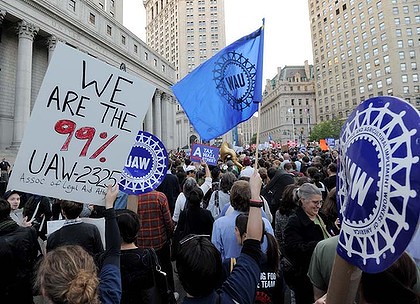
Unions gather on Wall Street to support the movement demanding economic justice. "Occupy Wall Street" has drawn the attention of people throughout the U.S. and the world., a photo by Pan-African News Wire File Photos on Flickr.
Risk chasers emerge as QE market winners
By Michael MacKenzie in New York and Ralph Atkins in London
Financial Times
A hallmark of Communist centralised planning was the celebrated five-year plan.
Next week the US – a bastion of laisser-faire economics – marks the fifth anniversary of the Federal Reserve’s switch to emergency interest rates anchored near zero per cent and to massive bond purchases.
Clear winners under this grand monetary policy experiment – emulated globally – have been investors who held their noses, ignored fundamental market principles and bought equities and risky bonds, whose prices have been buoyed on a massive tide of central bank liquidity.
“It is fair to say that the Fed has created a marvellous environment for virtually all assets, even if this remains one of the weakest economic recoveries on record in the US and through virtually all of the developed markets,” wrote Deutsche Bank in a note.
European high yield, or “junk”, corporate bonds have fared best, producing total returns of more than 150 per cent. Among the few losers were owners of Greek shares.
As the anniversary passes, however, the Fed – which starts a two-day meeting on Tuesday – may tell investors the time has come to begin scaling back, or “tapering”, its $85bn of bond purchases each month. Recent jobs data suggest the US economy is poised to grow faster in 2014; US equities are on track for their first two-week decline since early October, displaying some sign of taper nervousness.
Yet the Fed has not worked similar wonders for the real economy. “This five-year plan is clearly running its course; the liquidity helped the economy and confidence, however it has not prompted companies to boost their capital investment and spend more money,” warns Quincy Krosby, market strategist at Prudential Financial.
Rajiv Setia, head of US rates research at Barclays, adds: “There has been a debate about the benefits of QE and growing inequality. It should wind down, there is a limit to how beneficial rising asset prices feeds through to the broad economy.”
As the world emerges from the worst financial crisis since the Great Depression, rapid share price rises globally and the return of products characteristic of bubble eras – such as “covenant lite” loans and very low yielding “junk bonds” – raise concern that markets have been goosed by central bank liquidity and are destined for a substantial correction at some juncture.
In December 2008, when US policy makers hit the emergency monetary policy button, the crisis triggered by the collapse of Lehman Brothers threatened financial Armageddon.
The Fed cut sharply its main overnight rate from the then-record low of 1 per cent to a range of zero to 0.25 per cent. To buttress its mortgage bond buying programme, the Fed said it was evaluating purchasing longer-term Treasury securities.
Near zero interest rates combined with huge bond purchases in the open market – “quantitative easing” – took time to stabilise the economy and reverse the massive flight of investors from stocks and non-government bonds. But by backstopping markets, the Fed’s actions helped contain the crisis that bottomed in the spring of 2009, when the US S&P 500 share index dropped to a low of 666. Since then, the S&P has almost tripled in value. Germany’s Dax and Japan’s Nikkei 225 index have also been among the biggest winners.
Official interest rates at or near zero also persuaded bond investors to move wholesale into riskier products – rather than safe government debt yielding little. “Zero has become a very powerful number,” says Suki Mann, head of credit strategy at Société Générale.
During the depths of the crisis, high yield corporate bond markets priced in widespread bankruptcies. Once the Fed and other central banks acted and capital markets started functioning again, however, investors started a “dash for trash”.
Despite investors’ worries, inflation has not taken off – which has resulted in big reversals this year in gold and silver. But “a slow and gradual recovery developing over a number of years is the perfect scenario for corporate bonds – and that is what we have”, says Mr Mann.
The performance of other assets – such as oil and copper – has also ebbed more recently as a result of slower economic growth in emerging market countries and the growth of shale natural gas. New winners have emerged, however: among this year’s best performing assets have been Greek, Spanish and Italian shares.
If the Fed had a new five-year plan, one safe bet would be that assets would perform very differently. Investors face an environment of highly priced equities and bonds with still very low yields, notwithstanding the jump in benchmark rates since May, when Ben Bernanke, Fed chairman, first hinted at his plans to scale back, or taper asset purchases.
“We all face the challenge of swimming in an ocean where asset classes, at a minimum, are fairly valued,” says James Sarni, managing principal at Payden & Rygel.
Deutsche Bank made the point succinctly: “We did a back of the envelope calculation to work out where European High Yield [corporate bond] yields would have to go to see returns of 150 per cent over the next five years. The answer was around -47 per cent – although we’d warn you that the calculation did break our computer.”
No comments:
Post a Comment